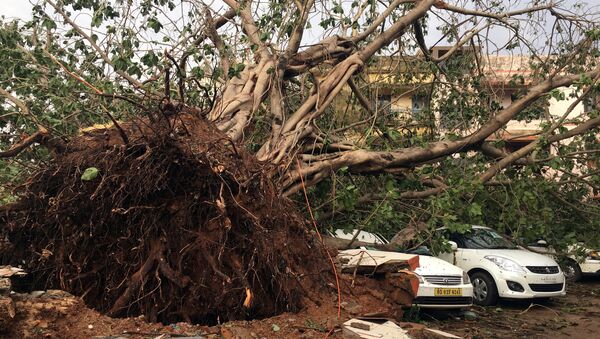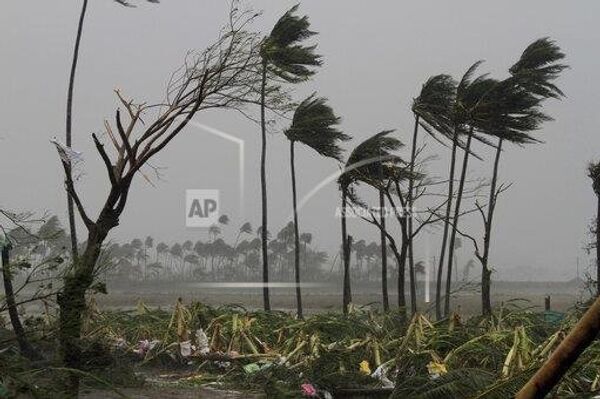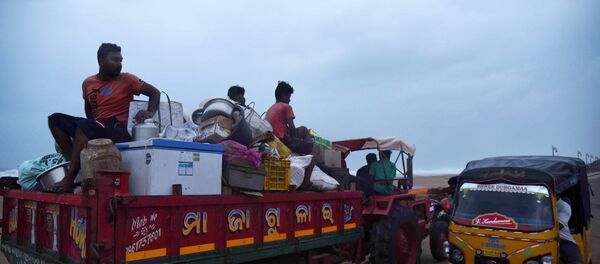New Delhi (Sputnik): India's National Disaster Response Force (NDRF) has been very successful in ensuring almost zero casualties recently in the country's Odisha state, despite devastation caused by the Cyclonic Storm "Fani" on 3 May, according to Disaster Relief chief Satya Narayan Pradhan.
Although there were 30 casualties, he said, it pales in comparison to 1999, when approximately 12,000 people were killed in the same region when it was hit by a similar natural calamity.
He shared that all efforts are being made to provide relief and rehabilitation to people in the coastal areas of Odisha, including basic necessities like food, electricity, and restoration of communication following the devastation.
National Crisis Management Committee, under Cabinet Secy. Sh. P. K. Sinha reviewed the rescue & relief measures in the cyclone #FANI affected areas of Odisha with senior officials of State Government & Central Ministries/Agencies concerned
— PIB India (@PIB_India) May 7, 2019
Read More: https://t.co/CI6cijZncF pic.twitter.com/Keii2Ja40v
In an Exclusive Interview with Sputnik, NDRF Director General Satya Narayan Pradhan cast light upon the overall endeavour of the National Disaster Response Force (NDRF) during the natural disasters.
Cyclone Fani has devasted Odisha. You can help #HelpRebuildOdisha by contributing to Odisha Chief Minister's relief fund at https://t.co/nc7zaQheKZ
— News18 (@CNNnews18) May 7, 2019
Or
You can transfer using the account details given in the video pic.twitter.com/5MTYZTJwXn
Sputnik: How successful has the NDRF been in the rescue and rehabilitation of people during and after Cyclone "Fani"? How was it made possible?
Pradhan: First thing is that we got a prediction well in time, almost seven to eight days in advance as to the course of the cyclone and we got the exact timing of the landing and the place of the landfall, and also at which speed it will hit the land.
On the basis of that, we contacted the government and we repositioned the team well in time, almost 72 hours in advance of the cyclone hitting. We repositioned almost 28 teams of the NDRF across the coastline in consultation with the state government. The state government kind of decided on the points of maximum impact.
The state authorities and we were together in this to convince such people and then, after that, the transition took place from their old huts/houses to the cyclone shelters and more than 10.5 or 11 lakh people (over 1.1 million people) were transferred to these cyclone shelters.
O-Disha to the world! #CycloneFani
— Manoj Mishra ମନୋଜ ମିଶ୍ର (@manojmishratwit) May 7, 2019
Cyclone Fani: UN praises India's response to devastating storm https://t.co/rZT3l7iA8a
Sputnik: Would you describe this as a very successful operation by the NDRF?
Pradhan: I would certainly describe it as a very successful operation, although we never define it that way; it is our duty anyway. The strategy is always very simple, it should be zero casualty, if we go by the zero casualty approach; it has been very, very effective, because zero casualty in what was 12,000 in the '99 (1999) cyclone, which was of a similar nature.
So, we reached a double (casualty) figure of 30, so that way I think those who have died, they died because they exposed themselves and did not listen to the advisory and made some errors of judgment… Those who ventured out got caught… That way I will call it a successful mission.
Pradhan: Absolutely, I think it will take some time. The three areas which have been most affected by the cyclone are the Puri district, Khordha district, which includes Bhubaneswar city. So, these three places affected the urban aspects of Puri, Khordha, Bhubaneswar, as well as the hinterland of those three places. They are the most affected and they are the built-up areas and urban areas and Bhubaneswar being the capital. So obviously, the damage has been extensive; all the trees have been uprooted, power lines are snapped and disrupted. In fact, even the poles are bent or uprooted, and that has also had an impact on the communications.
Sputnik: How much time, approximately, will be required for normalcy to return?
Pradhan: Some things have already started limping back to normal. In fact, the flight services have become near to normal — almost 90 percent; trains have already started, roads have been cleared of all debris. There were lakhs and lakhs of trees all over the place and the NDRF teams have been working non-stop 24/7 to clear the roads.
Cyclone Fani Ground Reports: ODISHA — PURI & BHUBANESHWAR
— NDRF (@NDRFHQ) May 7, 2019
𝐍𝐃𝐑𝐅 @ 𝐖𝐎𝐑𝐊 𝟒 𝐔 #TEAMNDRFINDIA #StaySafe #stayalert #stayprepared @satyaprad1 @PIBHomeAffairs @ndmaindia pic.twitter.com/xKKnMPsTsC
We have succeeded in clearing the roads between Puri and Bhubaneswar and between Puri and Cuttack, between Puri and Khorda, which are the lifelines, and also inside Bhubaneswar. Right now, our teams are distributed along the Bhubaneswar City Corporation.
Pradhan: There are 44 teams active right now… in five districts. Of the 44, at least 35 are active in these three places, including nearly 20 teams in Bhubaneswar itself.
PM @narendramodi visited Odisha to review the situation arising out of Cyclone Fani. He took part in a meeting of senior officers of the State and Central Government to take stock of the damage and the relief and rehabilitation measures being undertaken. pic.twitter.com/sA354AjxPt
— PMO India (@PMOIndia) May 6, 2019
Meanwhile, Odisha Chief Minister Naveen Patnaik told media outlets over the weekend that "People in cyclone shelters will be provided cooked food for [the] next 15 days and electricity and drinking water is being worked on war-footing so that it is supplied to people very soon. Condition is bad. Prime Minister (Narendra Modi) spoke to me. We are working very hard to restore communication too".
The state government has confirmed that the cyclone period has concluded, but there has been an enormous loss of livestock, crops, and other assets.






